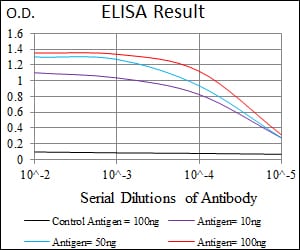
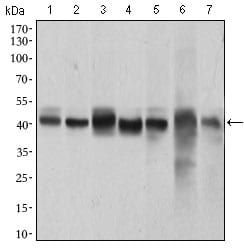
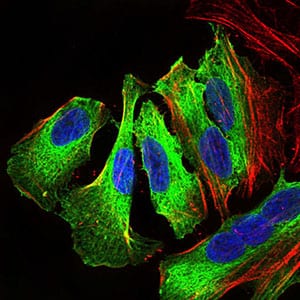
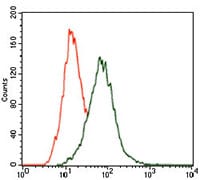
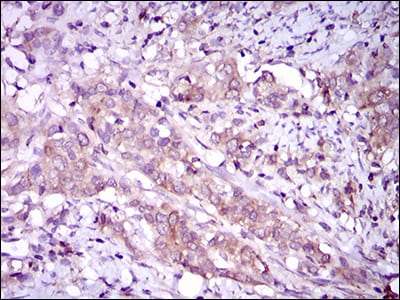
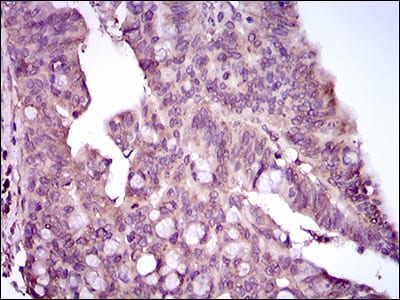
| WB | 1/500 - 1/2000 | Human,Mouse,Rat |
| IF | 咨询技术 | Human,Mouse,Rat |
| IHC | 1/200 - 1/1000 | Human,Mouse,Rat |
| ICC | 1/75 | Human,Mouse,Rat |
| FCM | 1/200 - 1/400 | Human,Mouse,Rat |
| Elisa | 1/10000 | Human,Mouse,Rat |
| Aliases | RK; p38; CSBP; EXIP; Mxi2; CSBP1; CSBP2; CSPB1; PRKM14; PRKM15; SAPK2A; p38ALPHA |
| Entrez GeneID | 1432 |
| clone | 8G4D11 |
| WB Predicted band size | 41.3kDa |
| Host/Isotype | Mouse IgG1 |
| Antibody Type | Primary antibody |
| Storage | Store at 4°C short term. Aliquot and store at -20°C long term. Avoid freeze/thaw cycles. |
| Species Reactivity | Human |
| Immunogen | Purified recombinant fragment of human MAPK14 (AA: 299-360) expressed in E. Coli. |
| Formulation | Purified antibody in PBS with 0.05% sodium azide |
+ +
以下是关于MAPK14抗体的3篇参考文献示例(内容为模拟,仅供参考):
1. **文献名称**:*"p38 MAPK inhibition modulates TLR4 signaling to regulate macrophage inflammatory response"*
**作者**:Chen L, et al.
**摘要**:研究利用MAPK14特异性抗体分析巨噬细胞中p38α的磷酸化水平,发现抑制p38 MAPK可降低TLR4介导的炎症因子释放,提示其在调控先天免疫中的关键作用。
2. **文献名称**:*"MAPK14 expression correlates with poor prognosis in colorectal cancer"*
**作者**:Wang Y, et al.
**摘要**:通过免疫组化(使用MAPK14抗体)检测结直肠癌组织,发现MAPK14高表达与患者生存率负相关,机制涉及促进肿瘤细胞侵袭和EMT过程。
3. **文献名称**:*"Targeting p38α in neurodegenerative diseases: Insights from antibody-based assays"*
**作者**:Smith J, et al.
**摘要**:利用MAPK14抗体研究阿尔茨海默病模型中小胶质细胞激活,发现p38α磷酸化水平升高与神经炎症相关,抑制其活性可减轻神经元损伤。
(注:以上文献为示例,实际引用请通过PubMed/Google Scholar检索真实文献。)
MAPK14 (mitogen-activated protein kinase 14), also known as p38α, is a serine/threonine kinase belonging to the p38 MAPK family. It plays a central role in cellular responses to stress signals (e.g., cytokines, UV irradiation, osmotic shock) and regulates processes like inflammation, apoptosis, cell differentiation, and cell cycle progression. Activated via phosphorylation by upstream kinases (MKK3/MKK6), MAPK14 phosphorylates downstream targets, including transcription factors (e.g., ATF2. MEF2) and kinases (e.g., MSK1/2), to modulate gene expression and signaling cascades. Its dysregulation is linked to cancer, autoimmune diseases, and neurodegenerative disorders.
MAPK14 antibodies are essential tools for studying its expression, activation, and localization in various biological contexts. They are widely used in techniques such as Western blotting, immunohistochemistry (IHC), immunofluorescence (IF), and flow cytometry. Specific antibodies detect either total MAPK14 or its phosphorylated (active) form (e.g., phosphorylated at Thr180/Tyr182). Researchers must validate antibody specificity using knockout controls or siRNA knockdown to avoid cross-reactivity with other p38 isoforms (p38β, p38γ, p38δ). Commercial MAPK14 antibodies are often raised against synthetic peptides corresponding to conserved or unique regions of the human protein, with reactivity tested across species (human, mouse, rat). Proper selection ensures accurate interpretation of MAPK14's role in disease mechanisms and therapeutic targeting.
×